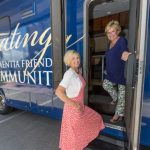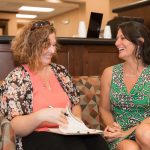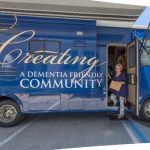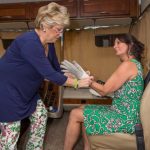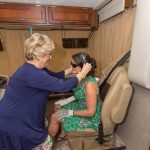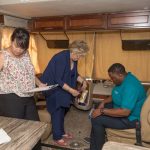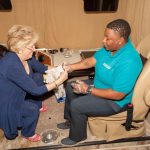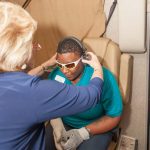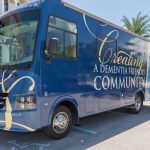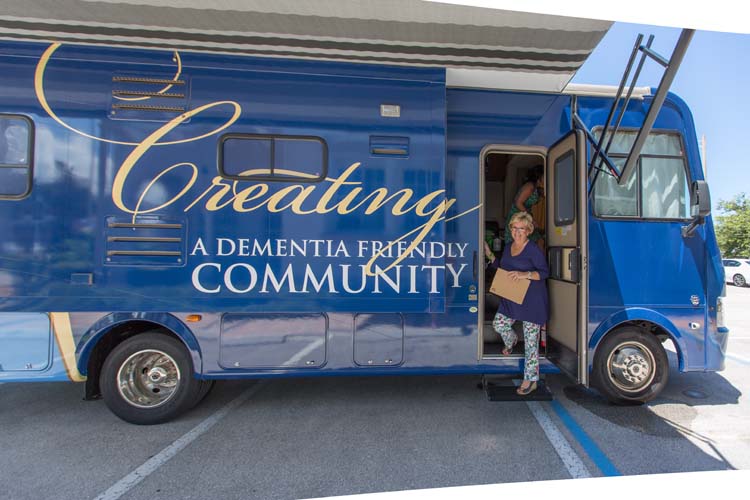
The numbers are alarming. According to Peggy Cunningham, executive director of the Alzheimer and Parkinson Association of Indian River County, statistics given them by the national Alzheimer’s Association indicate that in this county alone, an estimated 6,000 people are touched by dementia; a number due to double by 2030.
“We also know from their statistics that 80 percent of people with dementia are cared for by informal caregivers; unpaid family and friends,” says Cunningham. “They’re not the ones in memory care units. They are the ones in the community; they’re going to churches, they’re going to the grocery store, some of them are driving.”
To prepare for the growing demand, the APIRC is working toward making Indian River County a dementia-friendly community.
“If the whole community can understand how to embrace those folks with dementia and their caregivers and be able to help support them, then the quality of life for everybody is going to get better.”
One tool in their arsenal is the Virtual Dementia Tour, designed to mimic the effects of memory disorders in aging patients by disorienting the participants’ senses of sight, sound and touch. They have been licensed to conduct the tour for the past few years and now, thanks to a $100,000 grant from the generous ladies of Impact 100 to fund their Dementia Friendly Community Initiative, they will be taking it, along with some of their other programs, on the road.
“We’ve always been impressed by the impact that it has on people,” says Cunningham of the tour, which they have primarily been offering at their Memory and Motion facility near Miracle Mile. The grant enabled them to purchase a 27-foot Coachman Pursuit RV and hire a part-time outreach coordinator, creating a rolling classroom that can be taken right to the doorsteps of restaurants, shops, churches, businesses, medical offices, civic groups or neighborhoods. Boston Barricade assisted with colorful graphics and signage; making the RV highly visible on its travels about town.
“If we can start those awareness conversations where they feel comfortable, it starts the connections with families that we’re here when they need us. The other advantage to being able to take this out to businesses is to take away the stigma. If people are afraid of this then they won’t come looking for help. We want people to be educated about dementia, because once you know about it and it’s not so scary, that stigma will drop away and people will come for help earlier.”
During the tour, to simulate diminished physical and sensory skills, participants don headphones that play continual, disorienting noises; goggles that impair central and peripheral vision; uncomfortable shoe inserts that mimic the pain of neuropathy and gloves that replicate arthritis and weaken the sense of touch. After garbing up, they are given seven minutes to complete five simple tasks; quickly discovering that the distractions cloud their cognitive abilities.
“It’s the brain not getting information. So you get the effects of anxiety, frustration, knowing you’re supposed to do something and feeling bad because you can’t. They’ll stop before their seven minutes are up because they’ll say, ‘I can’t stand it.’ ‘I can’t remember.’ ‘It’s so frustrating.’ Or they think that they’ve done it all but they’ve only done part of it. Some of the tasks are double but very simple; find something and do something with it,” says Cunningham, adding most can only do three tasks or parts of all five.
Despite having taken the tour multiple times herself, when she and Erin Montegut, director of programs, went to Orlando for their yearly facilitator retraining, she had difficulty remembering her tasks. “So I began shadowing Erin, but she didn’t know what she was supposed to do either. That’s one of the things you see; people with dementia shadow you. We have people who come in and say, ‘I can’t even go to the bathroom by myself; he’s always there.’ That’s because he’s constantly, constantly trying to figure things out. He knows he’s supposed to be doing something but can’t remember what it is; the anxiety is there.”
One of the most important aspects of the program is talking to people afterward about the experience.
“Everybody has their own story; it’s highly expected that people will cry after it. All these emotions come tumbling out, which is also a good result, because then we can say, OK now let’s talk about what to do,” says Cunningham. Afterward, participants have a better sense of what people with dementia are dealing with and are more receptive to learning how best to communicate.
“And this is the important part, because the training of how you approach someone with dementia is so simple. It’s just not starting with your reality; it’s getting into their reality. That’s one of the first strategies,” she explains. “So if someone walks into the bank and you’re seeing those signs, your job isn’t necessarily to bring them to reality. The goal changes when you’re with someone with dementia. Your goal is, what’s going to make this moment positive right now.”
Cunningham says the best approach is to smile and provide reassurance with friendly, helpful kindness; emphasizing that you can help them but without taking away their sense of control.
“If you are taking care of your husband and he has dementia, don’t keep saying, ‘I just told you that; don’t you remember that?’ You say, OK and you let it roll off your back,” Cunningham suggests. “You keep everything very fun-loving because that’s what they thrive on. That’s what we set up in this social respite program we have. It’s fun loving and it’s shallow and conversations go like Alice’s tea party. But that’s OK.”
Equally important, family members should be informed that the local Alzheimer and Parkinson Assoc. has numerous programs and services they can take advantage of, such as Project
Lifesaver, which helps locate individuals who wander off, social respite at three locations, movement, art and dance programs, caregiver support and educational seminars.
A more extensive memory screening test than those given in doctors’ offices is another service they offer and with the rolling classroom they will be able to process even more people.
“Those are key; everybody over the age of 50 should be having a memory screening to get a baseline,” she says. And if there are concerns later on, people can retake the test to see where the changes, if any, might be.
“We can’t do anything about the course of the disease; it’s a progressive disease. But we can help families so that the quality of life is better along the way,” says Cunningham.
Sharing a positive outcome from a recent Virtual Dementia Tour Cunningham says, “We did this in a business and they had an incident and employees knew what to do because they had gone through the program. It’s going to be fun to see a year from now what kind of effect we’ve made.”
The local organization receives no monetary support from the state Alzheimer’s Association, relying solely on donations, grants and fundraisers, such as its Walk to Remember, scheduled this year for Nov. 17 at Riverside Park.
For information or to schedule training call 772-563-0505 or visit memoryandmotion.org.
- DIana Walker of CenterState Bank with Peggy Cunningham
- Erin Montegut and Delana Rollins
- Peggy Cunningham
- Peggy Cunningham prepares Delana Rollins from Ryan Weaver Insurance for the dementia simulation
- Peggy Cunningham prepares Delana Rollins from Ryan Weaver Insurance for the dementia simulation
- Lisa Harvey, Peggy Cunningham and T.J. Jones
- Peggy Cunningham prepares T.J. Jones for the virtual dementia experience.
- Peggy Cunningham prepares T.J. Jones for the virtual dementia experience.
- Alzheimer-Parkinson Association of IR County’s rolling classroom

